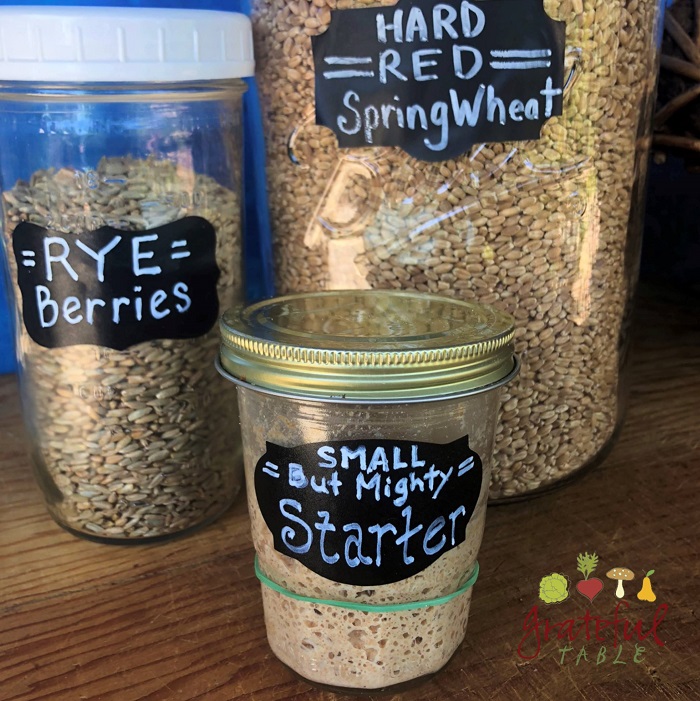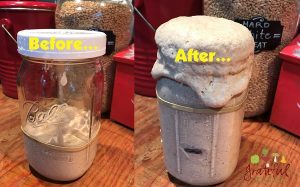There’s lots of info out there on how to baby our starter. Well… I’ve been conducting experiments to figure out how little I can baby my starter, and still have it turn out amazing bread.
In the process, I determined that my husband and I do not want to have to make pancakes every few days with the starter discard. And, making crackers with the discard seemed like too much work (to eat and to make…).
Now you might be fine with either of those solutions, to use up the starter discard that accumulates when room-temperature starter is fed twice-daily. If not, you might want to just refrigerate your starter for a week or so, between bread-making projects. Yes, you have to “revive” the starter. But you end up spending less time taking care of your starter.
 Start with starter! (Starter Recipe Here).
Start with starter! (Starter Recipe Here).
Early on, I’d heard that starter is so resilient, you could ignore it for months, and it would probably still come back to life. One blogger reported that she had some years-old starter in the fridge, and it was still good. I guess it’s true that it might still be “good” enough to revive, but…I’ll be using mine more often than that, which I’m sure is healthy for the starter…
In the old days, mine was a “liquid starter”. My mistake was in not realizing that the liquid starter eats through its food quicker, and is thus not quite as suitable for storing in the fridge. What I needed for that was a “dry starter”, which is thicker and slower to feed.
So I switched from cultivating a liquid starter to a dry starter, leaving my starter out in a warm place, feeding it twice daily. This new, lively started made some really good breads, even if I was to refine the method a bit more as time went on. (Twice daily feedings is a bit much!)
Now here are some scientific facts to chew on, and maybe inspire you too:
- Starter gets a more acidic, sour flavor when it grows slowly under refrigeration, since the cold encourages the production of acetic acid. Some folks may prefer this, so keep that in mind.
- Besides temperature, frequency of feedings also affects flavor, by changing the balance of yeast and bacteria in the starter. Fed less often, bacteria will proliferate, eventually making for a very sour bread. Fed more often, in a warm environment (like in an oven with the light left on, if necessary), yeast takes the lead. I suppose that’s why my recent breads received rave reviews. I “grew” the starter in a warm place, feeding it twice daily. My one son said of one recent loaf, “I think this is the best bread you’ve ever made. I mean, wait- I think it’s the best bread I’ve ever had. In my life.” Wow, that’s high praise.
- Another thing to consider: Moisture. The almost-buttery flavor of lactic acid likes a moist environment. A more-liquid starter might help promote this, although I’ve still had excellent flavor using a stiff starter with a moist dough. Still, something to keep in mind.
- Use unchlorinated water. (I have a Berkey, which gives me wonderful water for all my fermentation needs- kombucha, kefir, and sourdough.) The chlorine in a lot of tap water will kill some of the starter critters you’re trying to encourage.
- Whole-grain flour will encourage more of the good yeasts and bacterias. (Unbleached, all-purpose flour can also work, if necessary.) “Hard red winter wheat”, “hard white wheat” and “hard red spring wheat” are all options. (I use these red wheat berries for my starter.) Soft winter wheat, either red or white, is better for pastries and cake-making, so skip those.
- Rye has amazing qualities of its own, making it particularly good to include in starter-feedings. I use a blend of half wheat and half rye berries, grinding those into a flour for starter feedings, keeping the extra in the freezer for future feedings.
- About stiff and liquid starters: Many folks say an artisan bread is best made with a stiff starter, so I turned my liquid starter into a stiff starter, which has about three parts flour to a two parts water by weight, or almost double the volume of flour to water by the cup. (Maurizio from “The Perfect Loaf” goes into detail here and has a helpful, in-depth post on starter maintainace, here.) Liquid starter, on the other hand, has a ratio of about two parts flour to 3 parts water by weight, or equal parts flour to water by volume.
Sourdough Starter Maintenance
You CAN remove some starter at each feeding, so that the starter being fed, which might be left out on the counter, continues to be very active. You then refrigerate the excess starter that’s removed before each feeding, letting it accumulate in a container, to use for crackers or pancakes.
OR, you can feed a small amount of starter, then refrigerate half of it for a week or so, to use for the next batch of bread. By refrigerating some freshly-fed starter, it will stay happy for about a week, if it’s been fed roughly an equal amount of flour by weight, to the amount of starter.
Then, just bring the jar back out for a new feeding when planning another bread-making project. Feed it, reserving some for the refrigerator, while using the rest. “Rinse and repeat”- you get the idea, right?
Make adjustments to suit conditions, so that the starter doubles and just starts to cave in a bit, before the next feeding. This might mean leaving the starter in an oven with the light on in colder climates. With our cool, Bay area weather, that has worked out well for me.
Refrigerated starter does need to be brought back to warm room temperature for a day or two, to be built back up with twice-daily feedings, for bread-making, as needed. This is called “reviving” it.
INGREDIENTS
- 1/4 c. starter*
- 1/3 c. water*
- 1/2 c. flour*
In small jar, mix together: > 1/4 c. starter > 1/3 c. water > 1/2 c. flour
Refrigerate half of starter, covering with a loose lid. Leave the rest in a warm spot for 12 hours or so, until doubled. When it just begins to cave in, feed again.
I “build” my starter up for two or three feedings (which takes a day or two at room temperature). I then use that whole amount when making the next batch of bread- anywhere from .12 starter, up to .50 starter. This gives me bread variations that work with different schedules I may have.
Bottom line, refrigerated starter gets revived by leaving the starter out for its feedings for a day or two, to get it back in good standing for excellent bread-making. And there’s no over-abundance of starter-discard-buildup!
- I find that using the scale is easiest. Here’s the quantities I like to use, when reviving a starter, going by weight: .06 lb. refrigerated starter, .06 lb. whole wheat/rye flour blend, .04 water


One Response to “Sourdough Starter Maintenance & Use & Other Details”